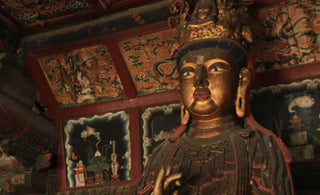
In the realm of classical Oriental art, the Liao Dynasty (907-1125 AD) stands as a beacon of spiritual and artistic enlightenment. This era, a crucial period in Chinese history, witnessed the creation of some of the most exquisite Buddha statues, each a testament to the spiritual depth and artistic mastery of the time. These statues are not mere artifacts; they are a bridge to the spiritual world of ancient China, offering us a glimpse into the beliefs, traditions, and artistic excellence of the Liao Dynasty.
The Artistic Heritage of the Liao Dynasty
The Liao Dynasty, a period marked by its extraordinary cultural diversity, political stability, and economic prosperity, stands out as a golden age in the history of Oriental art. This era, which lasted from 907 to 1125 AD, was characterized by a remarkable synthesis of artistic traditions, both indigenous and foreign, fostering an environment where arts and crafts not only flourished but evolved in unique and enduring ways.
The Buddhist statues from this period are particularly renowned for their serene beauty and intricate detailing. Crafted by skilled artisans who mastered a range of techniques, these statues are distinguished by a unique style that blends traditional Chinese artistic motifs with the influences of the nomadic Khitan people, the ruling class of the Liao Dynasty. This fusion resulted in a distinct aesthetic that is both elegant and bold, reflecting the cultural complexities of the era.
Symbolism and Spirituality in Liao Art
The art of the Liao Dynasty is characterized by its sophisticated use of symbolism and spirituality. Each Buddha statue is not just a visual representation but a narrative piece, imbued with layers of meaning. The artisans, who were both craftsmen and storytellers, utilized their skills to convey Buddhist teachings and philosophies. The statues are often adorned with intricate lotus motifs, a symbol of purity and spiritual awakening in Buddhist iconography. The lotus, emerging unblemished from muddy waters, represents the ability of the human spirit to transcend the murkiness of material life and attain enlightenment.Moreover, the statues feature various mudras or hand gestures, each signifying different aspects of the Buddha's teachings. These gestures, ranging from the Abhaya Mudra symbolizing fearlessness and protection to the Dharmachakra Mudra representing the teaching of the dharma, are intricately crafted, adding layers of meaning to the statues. The facial expressions of these statues also play a crucial role in their spiritual significance, often depicting a serene composure that invites contemplation and inner peace.
The Buddhist statues of the Liao Dynasty thus represent a high point in the history of Oriental art, where the physical form of art was seamlessly integrated with spiritual content. These masterpieces not only serve as a testament to the artistic skills of the period but also as a bridge to the spiritual world of ancient China, offering modern viewers a glimpse into the rich tapestry of beliefs and traditions that shaped this
Craftsmanship and Materials: The Hallmarks of Liao Statues
The Buddha statues of the Liao Dynasty, a testament to an era rich in artistic mastery and spiritual depth, stand as enduring symbols of the dynasty's craftsmanship and innovative use of materials. These statues, crafted between the 10th and 11th centuries, showcase the exceptional skills of Liao artisans who utilized a variety of materials including bronze, stone, wood, and ceramics. Their approach to material selection and artistic execution was not only advanced for its time but also indicative of the dynasty's wealth and cultural priorities.
Bronze, valued for its durability and lustrous finish, was a favored material for statue-making. The Liao Dynasty artisans exploited its malleability to craft intricate details and expressive facial features, often finishing the statues with gilding or inlays of precious metals like gold and silver, which added a divine aura to these sacred figures. Stone, another commonly used material, was carved with precision and care, resulting in statues that exuded both a sense of solidity and grace. Wood, though less durable than bronze or stone, allowed for greater flexibility in design and was often used for larger, more elaborate statues found in temples and monasteries.
Ceramics, a material not traditionally associated with Buddha statues, were also employed by Liao artisans. These ceramic statues were often smaller and more intricate, showcasing the dynasty's innovative approach to traditional art forms. The addition of gold leaf, silver, and precious stones like jade and turquoise not only enhanced the aesthetic appeal of these statues but also held symbolic meaning, representing the divine and enlightened nature of the Buddha.
The Liao Dynasty Statues in the Modern Era
In the modern era, the Buddha statues of the Liao Dynasty continue to captivate a global audience. Their historical significance, coupled with their timeless beauty, makes them highly valued by artists, collectors, and enthusiasts alike. These statues are more than just artifacts of a bygone era; they are a source of inspiration and contemplation. In contemporary spaces, be it in museums, galleries, or private collections, they serve as a bridge between the ancient and the modern, reminding us of the enduring legacy of Oriental art.
The intricate craftsmanship and the thoughtful use of materials in these statues not only highlight the artistic capabilities of the Liao Dynasty but also their understanding of the spiritual essence of Buddhism. Each statue, whether made of bronze, stone, wood, or ceramics, is a physical representation of the Buddha's teachings, serving as a medium for spiritual connection and reflection. Their presence in modern times continues to offer a window into the rich spiritual and artistic heritage of ancient China, underlining the timeless relevance and appeal of these masterpieces.
At Oriental Aesthetics, we are dedicated to preserving the rich heritage of Oriental art, with a special focus on the magnificent Buddha statues of the Liao Dynasty. Our expert team provides high-quality professional services, including consultations, restoration, and valuation, for collectors, artists, and enthusiasts who appreciate and love classical Oriental art. We believe in the timeless beauty of these ancient masterpieces and are committed to sharing their splendor with the world.
























